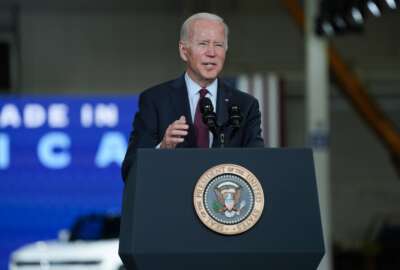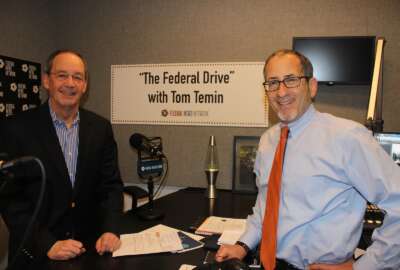Meet the new second in command of procurement at the IRS
New IRS Deputy Chief Procurement Officer Guy Torres has long federal and private sector experience.
Best listening experience is on Chrome, Firefox or Safari. Subscribe to Federal Drive’s daily audio interviews on Apple Podcasts or PodcastOne.
At the IRS, like a lot of large agencies, procurement, technology and mission are all tied together. Now the IRS has a new deputy chief procurement officer, someone with long federal and private sector experience. Guy Torres joined the Federal Drive with Tom Temin in studio.
Interview transcript:
Tom Temin: Guy, good to have you in.
Guy Torres: Great to be here. Thanks, Tom.
Tom Temin: And let’s begin with the fact that you are the deputy chief procurement officer. How do you divide the duties between you and the chief procurement officer?
Guy Torres: Great question, Tom. So in many cases, the chief procurement officer is the senior procurement executive who’s really drawing the strategic needs and strategic vision for the organization. While I am actually as the deputy trying to carry out those expectations as well as handle the tactical contracting operations procurement needs that we see day to day within the organization.
Tom Temin: And you came into the IRS just a few weeks ago, a couple of months ago. And did you slip into something that was kind of quietly going along and you could take your time getting up to speed or was it jumping into whitewater?
Guy Torres: It was jumping into cold whitewater, actually, Tom. It was three months drinking from the firehose, multiple firehoses to be honest with you. A lot of challenges, a lot of changes happening right now at the IRS. So we’re trying to bring best procurement actions, best procurement practices to this group to support the multiple missions that we’re seeing ahead of us here at the IRS.
Tom Temin: And two of the big areas – one, there is the digitization office, and they say not digitizing, but digitalizing. They make that distinction there of going on for the whole area of customer service. Then there is the long standing modernization of the back office systems, the master data file system and so forth. Are you involved with procurements related to those because those seem to be like front and center.
Guy Torres: Those are going to be the priorities right now, as you see within the IRS, trying to make the organization faster, quicker, giving the taxpayer a better customer experience, at the same time providing enforcement capabilities to deter the fraud as well as the identity theft issues that are actually happening right now facing the American taxpayers. So those are absolutely on point for what we’re trying to do. And having IT modernization will enhance those capabilities that we need to deliver.
Tom Temin: And what are these missions in these groups doing this type of work, telling you they need from the procurement function?
Guy Torres: So what they need for the procurement function, Tom, is a desire to provide faster, quicker agile and innovative procurement solutions, keep pace with technology. So my job is to try to deliver those services, at the same time maintain their procurement, integrity of the federal procurement process, ensure we are exercising contracting actions that are in the best interest of the public good.
Tom Temin: And one of those functions, the digitalization office has some 14 contracts on the street that are waiting for delivery of goods under those, and they were all executed – the contracts – in a period of weeks. And that’s interesting, because the IRS does not have “other transaction authority” authority, like a lot of agencies do. So you’ve pretty much do everything through the FAR. And yet they were able to demonstrate how fast you can get contracts for crucial projects onto the street. So tell us about the idea of speed. And the need for speed, which is something coming from the administration quite often in a lot of domains, how that comes down to procurement, when you don’t have OTA and you’ve just got the FAR.
Guy Torres: So again, we’re trying to find innovative ways through the FAR, actually, to maintain procurement integrity and deliver procurement services and goods while keeping pace with technology. Because technology is evolving, right. And we need to continue to have technology to support our missions. So we’re finding creative ways, legal within the realm of FAR, and provide, execute. As opposed to being risk averse we want to be proactive, and try to lean forward to provide those best practices that we feel can help the customer, which in our case is the CIO, to other organizations within IRS.
Tom Temin: Sure. And of course, the FAR is a pretty flexible document. It’s like a violin, you just have to know how to play it.
Guy Torres: Play it well, right? But make mistakes, but play it well. And it’s about practice and practice and practice, Tom.
Tom Temin: And you can always put in a new string if you break one. We’re speaking with Guy Torres. He is recently appointed the new deputy chief procurement officer at the IRS. And let’s talk about you for a minute, you have been in government, you’ve done procurement, you had a stint at Customs and Border Protection – another agency that has really yanked itself into the digital age, through at least one project I’m familiar with is to automate the dozen scores, maybe hundreds of forms that it puts out for people that it encounters. What did you learn there and how does that help the IRS work?
Guy Torres: When I was at CBP, I was fortunate to be managing the largest IT acquisition portfolio in DHS that represent 40% of our annual budget, about $1.5 billion at that time. And when I was at CBP the IT modernization effort that was happening at CBP is very similar to what I’m experiencing here at IRS and actually prepared me very well for what I’m expecting to happen here at the IRS as we lead IT modernization And the key takeaways I had when I was at CBP that helped us be successful was our ability to partner up for dinner early with our program office to help them define their requirements, as well as provide active and engaging industry transparency, which was helping provide best solutions and continued collaboration with industry that will help deliver those requirements that we needed.
Tom Temin: And the more you can do that, I guess the more agile the whole thing can become, in a way paralleling the agile development methodology of the projects themselves, fair enough?
Guy Torres: Yes.
Tom Temin: All right. And you don’t like to pick the easy agencies, you also had roles at the Marine Corps, also, at the FBI, tell us a little bit about those.
Guy Torres: It was a fantastic opportunity. So I was fortunate to be commissioned in the Marine Corps and was in the Marine Corps for over 10 years. And when I retired out of the Marine Corps I was fortunate to get an opportunity to work as a unit chief within the FBI. And it was fantastic working with a great law enforcement agency.
Tom Temin: All right. And on the private sector side, I’m looking at your biography. You were Homeland Security account executive at Northrop Grumman. That is a big job. How did that inform your understanding of what it’s like from the government side to deal with industry, having to deal with government from the industry side?
Guy Torres: Great question, Tom. And I think it actually helped me have a better appreciation and deeper understanding of how important it is for the government to define their requirements. When I realized when I was in the private sector, you get an understanding of the vagueness and this requirement ambiguity, I realized that on the industry side, we end up spending a lot of money and a lot of time – the cost of doing business of trying to define what does the government really want. So the takeaway I received from that was in my current job, now, my goal is to ensure that we and the Office of Procurement Operations, we do a better job with our program managers, partner with them to help define and refine that requirement, as well as to be able to communicate in a way that makes sense. And it’s simple and less complicated. Because if you make it less complicated, it’s easier for the industry to understand it, and to provide you a solution that makes sense and supports mission. So that’s what my end in mind is there.
Tom Temin: But if you are, say, specifying or setting requirements for replacement jack screws for an airplane aileron, then you can provide a drawing and it’s very detailed and the threading on the screws and so forth. How do you translate that precision in requirements to something like we want to improve customer experience using these forms and automate these forms?
Guy Torres: Well, when you’re looking at a more open need, open requirement, part of the engagement with industry will be to have an active give-and-take, an active engagement with industry on multiple levels, multiple times to help provide information, offer information, as well as seek information from industry and bring in industry to provide those additional requirements. And help us define it. We’re doing that now in many cases, on the IT modernization effort, you’ll see more of that in future as when we will solicit information to obtain ideas and help us, help define these requirements, because we know where we want to go. But maybe we need to tweak it to how we get there. And we would love to have industry’s input because they are going to be our partner. And our success is industry engagement and how they can be a partner with us as we move forward.
Tom Temin: And is it also important to convince the program owners that maybe don’t try to buy the whole thing all at once. But pick your increments with that end goal in mind? Because that seems to be the trend, too, also, to get away from the grand design types of failures.
Guy Torres: You mentioned working with the program managers. And another one of our goals within the Office of Procurement Operations is to ideally become that credible, trusted adviser to the program manager and the program officers. So we are a force multiplier as opposed to being an impediment or a roadblock in a supply chain.
Tom Temin: And after three months, do you like it at the IRS?
Guy Torres: I really do. It’s a great question. I am laughing as you said because I do like it and what I like about it is the people. The people are dedicated and people are focused and people want to make a difference and it’s a great place to be right now.
Tom Temin: Guy Torres is Deputy Chief Procurement Officer at the IRS. Thanks so much for joining me.
Guy Torres: My pleasure.
Copyright © 2025 Federal News Network. All rights reserved. This website is not intended for users located within the European Economic Area.
Tom Temin is host of the Federal Drive and has been providing insight on federal technology and management issues for more than 30 years.
Follow @tteminWFED






